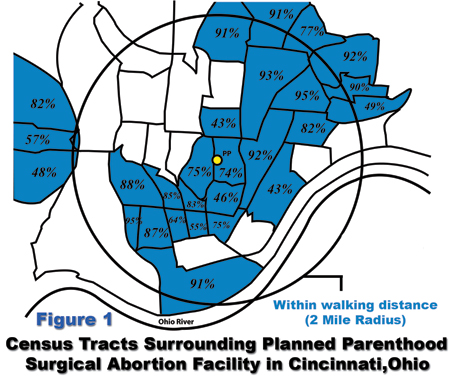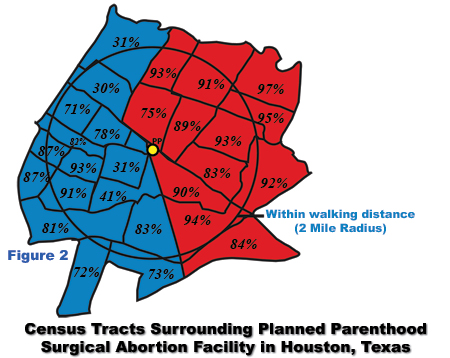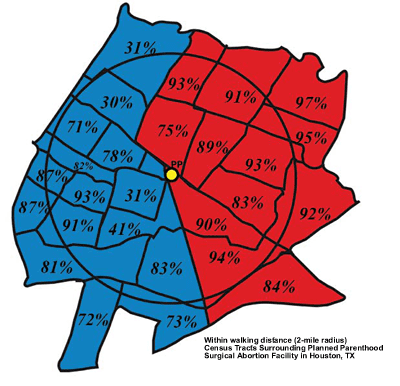Why are Black women over 3 times more likely to obtain an abortion than White women?1 Even though African Americans are only 12.6% of the population, they received 30% of the 1.2 million abortions in 20082 (latest available statistics), killing 360,000 Black babies at a rate of nearly 1,000 per day. More than 16 million African American unborn babies have died from legalized abortion3, which suggests that the current Black population of 39 million would have been more than a third larger without abortion. This scourge is the leading cause of death for African Americans, more than all other causes combined, including AIDS, violent crimes, accidents, cancer and heart disease4. African Americans have been disproportionately hurt by abortion because they have been targeted from the beginning. This is truly a case of Black genocide, and Planned Parenthood is one of the major players in this tragedy.
Life Issues Institute’s recent analysis of 2010 Census Bureau5 data shows that Planned Parenthood continues to strategically place the majority of their surgical abortion facilities in locations that target Black Americans for abortion6. This analysis shows that 62% of Planned Parenthood abortion facilities are within walking distance (2 miles) of relatively high African American populations. In 2005, Life Issues Institute was the first to use Census 2000 data to document Planned Parenthood’s placement near minority neighborhoods; this updated research uses the newest census data to thoroughly examine the neighborhoods around their abortion facilities.
In this study, the percentage of African Americans was calculated for every census tract within walking distance of the 165 Planned Parenthood surgical abortion facilities operating in 20107. Census tracts are subdivisions designed to delineate areas whose populations are fairly homogeneous in certain ways, such as income level or housing stock.
Although the total populations of census tracts usually vary from 2,000 to 6,000 people, some have as many as 14,000 inhabitants. Some are large in area and others are very small. But overall, census tracts resemble neighborhoods because of their homogeneous nature and thus they can effectively identify minority neighborhoods.
As an example, Figure 1 illustrates the location of a Planned Parenthood abortion facility on the census tract map of Cincinnati, Ohio. The 2 mile radius around the abortion facility (labeled “PP”) is indicated by a large circle and each census tract is marked with the percentage of African Americans who live there. This approach was used to analyze the Black populations surrounding each of 165 Planned Parent-hood surgical abortion facilities.

Our analysis shows that 102 out of 165, or 62% of the Planned Parenthood abortion facilities are located in areas with relatively high African American populations, or in “targeted neighborhoods.” An abortion facility is considered to be in a targeted neighborhood if at least one census tract within walking distance has an African American population that is at least 50%, or 1.5 times the percentage of the surrounding county8. The majority of targeted neighborhoods are composed of several census tracts with relatively high African American populations. In Figure 1, the targeted neighborhood of African Americans is represented by the blue census tracts, each of which have an African American population which is at least 1.5 times higher than the Hamilton County average of 25.7%.
When the 4 census tracts with the highest Black percentages in all of the 102 targeted neighborhoods were taken together, their average Black population was 44.8%, nearly 3 times higher than the 15.6% average Black population of the 102 counties where they were located, and 3.5 times higher than the national black population of 12.6%.
These census results reveal the extent of Planned Parenthood’s purposeful presence near African American neighborhoods. But it doesn’t stop there. Hispanic women also appear to be a target, as they are nearly twice as likely to obtain an abortion as White women.
An identical examination of the Census 2010 data for Hispanic or Latino populations shows 105 out of 165 or 64% of the Planned Parenthood abortion facilities were located within walking distance of relatively high Hispanic populations9. Using the same method as above, the 105 Hispanic targeted neighborhoods show a top 4 census tract average that is 45.0% Hispanic, which is more than double the 20.8% Hispanic average of the 105 counties and 2.7 times higher than the national Hispanic population of 16.3%.
When looking at both minorities in combination, the data reveal that 79% of Planned Parenthood abortion facilities are located near either an African American or a Hispanic neighborhood and 45% are placed so that they are within walking distance of both types of minority neighborhoods.
As an example, Figure 2 shows the census tracts surrounding a Planned Parent-hood abortion mega-facility that opened as recently as 2010 in Houston, Texas. The census tracts in blue show the African American targeted neighborhood and indicate African American percentages; the census tracts in red show the Hispanic targeted neighborhood and indicate Hispanic percentages. This provides evidence that Planned Parenthood continues to choose locations that target minority communities.
 One other important demographic appears to be college-aged women (20-24 years), who receive 32% of all abortions. The data show that 124 out of 165 or 75% of Planned Parenthood abortion facilities are located within walking distance of at least one college campus. In fact, a common pattern for Planned Parenthood is a location that splits the difference between an African American neighborhood, a Hispanic neighborhood, and a college campus; 33% of their abortion facilities have a location that is clearly situated to be within walking distance of all three demographics. Their proximity to these targets is clearly intentional, because 88% of their abortion facilities are located near at least one of these demographics.Interestingly, in the cities that have targeted neighborhoods, Planned Parenthood tends to place their facilities in census tracts that have relatively low minority populations, even though they are adjacent to census tracts with relatively high minority populations. The Planned Parent-hood abortion facility census tracts have an average African American percentage of only 22.2% and a Hispanic average percentage of 27.1%, significantly lower than the averages of the targeted neighborhoods’ top 4 census tracts, 44.8% and 45.0%, respectively.
One other important demographic appears to be college-aged women (20-24 years), who receive 32% of all abortions. The data show that 124 out of 165 or 75% of Planned Parenthood abortion facilities are located within walking distance of at least one college campus. In fact, a common pattern for Planned Parenthood is a location that splits the difference between an African American neighborhood, a Hispanic neighborhood, and a college campus; 33% of their abortion facilities have a location that is clearly situated to be within walking distance of all three demographics. Their proximity to these targets is clearly intentional, because 88% of their abortion facilities are located near at least one of these demographics.Interestingly, in the cities that have targeted neighborhoods, Planned Parenthood tends to place their facilities in census tracts that have relatively low minority populations, even though they are adjacent to census tracts with relatively high minority populations. The Planned Parent-hood abortion facility census tracts have an average African American percentage of only 22.2% and a Hispanic average percentage of 27.1%, significantly lower than the averages of the targeted neighborhoods’ top 4 census tracts, 44.8% and 45.0%, respectively.
This makes perfect sense. Although there is no doubt that Planned Parenthood considers many factors when choosing the placement of an abortion facility, it would seem reasonable that visibility, bus lines and a location that provides an impression of medical respectability would be of primary concern, thus suggesting a less residential area.
It is also likely that Planned Parenthood prefers to be in the daily traveling vicinity of a minority neighborhood, but not in the middle of one. This allows for a familiar but “professional” distance. As a type of “community center,” they can provide birth control to the surrounding neighborhoods and build relationships with the women. Then, when the birth control fails, as it has for 54% of women who have abortions10, Planned Parenthood is perfectly positioned to provide abortions to these women in crisis, solving their “problem” for a nice profit.
However, this professional distance may be intentional for another reason. It provides cover for Planned Parenthood against the accusation that they locate in minority neighborhoods. This is a charge that they attempt to refute in a Guttmacher Institute study11 claiming that abortion facilities do not target minority neighborhoods. This 2011 analysis looked at “all known abortion providers,” including Planned Parenthood, but only those that perform at least 400 abortions annually.
The Census 2010 data shows that 48 out of 165, or 29% of the Planned Parenthood abortion facilities are within walking distance of a census tract that is at least 50% African American. In contrast, Guttmacher’s analysis showed that only “9% of abortion facilities were located in neighborhoods where one-half or more of the residents were black.” Guttmacher also claims that only 12% were located in neighborhoods where one-half or more of the residents were Hispanic. Instead, the Census 2010 data shows that 55 out of 165, or 33% are within walking distance of a census tract that is at least 50% Hispanic. The census tract data provide an accurate portrayal of the populations around Planned Parenthood abortion facilities, refuting Guttmacher’s claim.
However, the key concept missing in the Guttmacher approach is that these minorities do not need to be 50% of the population in order to signify a relatively high population presence. With national percentages of only 12.6% and 16.3%, respectively, African American and Hispanic neighborhoods can represent less than half of a census tract population and still be concentrated enough to capture the interest of Planned Parenthood.
For example, in the Seattle, Washington targeted neighborhood, the highest African American census tract percentage is 33%, more than 5 times higher than the county level of 6%. The state African American population is only 3.6% and the city is 7.9%. The average percentage of the targeted neighborhood’s top 4 census tracts is 29%, 4.7 times higher than the county level and 3.7 times higher than the city level. Even though these African American percentages are lower than 50%, Planned Parenthood has clearly chosen a location closest to the highest concentrations of African Americans in the area.
The census data verify the fact that Planned Parenthood places the majority of their abortion facilities within walking distance of relatively high minority populations, but does this prove that they are targeting minorities in general and African Americans in particular? Founder Margaret Sanger’s ties to the eugenics movement characterize Planned Parenthood’s origin and purpose.
In short, Margaret Sanger believed, as did the Eugenics Society of America with which she associated, that there was no room in society for the “feeble-minded.” This was a code word for Blacks, the poor, and others that they considered “unfit” and incapable of providing for themselves. She clearly believed that these people should not reproduce and advocated sterilization for the “undesirables.” Eugenic population control was her goal, and targeted birth control was her method for achieving it.12
In 1939, she began the “Negro Project,” which was intended to stop the growth of the Black community and which enrolled Black pastors to sell the program to their congregations. In a letter to Clarence Gamble, she wrote, “We do not want word to go out that we want to exterminate the Negro population, and the minister is the man who can straighten out that idea if it ever occurs to any of their more rebellious members.”13
After Hitler’s eugenics-based holocaust roiled the world, eugenicists changed their terminology to “population control,” but the intent was the same. When abortion became legal, the eugenicists had finally found an effective and legal way to advance their agenda, and Planned Parenthood placed its facilities in Black neighborhoods to continue to control and reduce the Black population.14 This strategy produced the intended results: Black women began aborting their babies at a rate 3 times higher than White women. Today, although Planned Parenthood tries to ignore its eugenics roots, and denies positioning its facilities near African American neighborhoods, these census tract results show that they continue to do so with impunity.
The census results also indicate that Planned Parenthood’s strategy is to be the convenient abortion locale for anyone at risk, aggressively targeting all of the demographics most likely to bring in abortion income. In Fiscal Year 2009-2010, they earned an estimated $154,000,000 from the 329,445 abortions they performed15,16, an estimated 40% of which were minority babies.
In the same year, Planned Parenthood also received $478,400,000 (46% of their annual budget) in taxpayer funding.17 While they claim that no tax money is used for abortions, this government largesse frees up other funds for paying abortionists, keeping the lights on in abortion facilities and building new mega-abortion facilities in minority neighborhoods. Most tragic and offensive is the fact that the tax money of African American citizens is being used to target the destruction of their own unborn children. If all African Americans knew about this purposeful elimination of their offspring, they would mobilize their neighborhoods against it. Then, the long nightmare of Black genocide might one day come to an end.
1. Centers for Disease Control and Prevention, Abortion Surveillance -United States, 2008, Table 13; accessed at: http://www.cdc.gov/mmwr/preview/mmwrhtml/ss6015a1.htm?s_cid=ss6015a1_w
2. Guttmacher Institute, Facts on Induced Abortion in the United States, August 2011; Accessed at: http://www.guttmacher.org/pubs/fb_induced_abortion.html
3. Human Life Alliance, Did You Know? Facts & Stats, p. 9; Accessed at: http://www.protectingblacklife.org/educational_tools/pdf/did_you_know.pdf
4. Ibid, p. 12
5. U.S. Census 2010, Interactive Population Map; accessed at: http://2010.census.gov/2010census/popmap/
6. This does not include the 150 Planned Parenthood facilities that do not do surgical abortions but do dispense the RU-486 abortion drug.
7. Information collected and provided by STOPP, 2010.
8. Census tracts with African American percentages less than 12.6% (the national average) were not considered targeted communities.
9. Census tracts with Hispanic or Latino percentages less than 16.3% (the national average) were not considered targeted communities.
10. Guttmacher Institute, Facts on Induced Abortion in the United States, August 2011; Accessed at: http://www.guttmacher.org/pubs/fb_induced_abortion.html
11. Guttmacher Institute, Claim that Most Abortion Clinics are Located in Black Neighborhoods is False, Guttmacher Advisory, January 2011
12. Elasah Drogin, Margaret Sanger, Father of Modern Society, (CUL Publications) 1989; pp. 11-22.
13. Franks, Angela, Margaret Sanger’s Eugenic Legacy, The Control of Female Fertility, McFarland and Company, Inc., 2005; pp. 43.
14. Life Dynamics Incorporated, Maafa 21, Black Genocide in 21st Century America, 2010.
15. Ertelt, Steve, Planned Parenthood Report: $1B Group Gets 46% From Tax Money, LifeNews.com, December 30, 2011. Accessed at:
Planned Parenthood Report: $1B Group Gets 46% From Tax Money
16. Planned Parenthood Annual Report 2009-2010, p. 9; accessed at: http://issuu.com/actionfund/docs/ppfa_financials_2010_122711_web_vf?mode=window&viewMode=doublePage
17. Planned Parenthood Annual Report 2009-2010, p. 9; accessed at: http://issuu.com/actionfund/docs/ppfa_financials_2010_122711_web_vf?mode=window&viewMode=doublePage

One thought on “New Research Shows Planned Parenthood Targets Minority Neighborhoods”